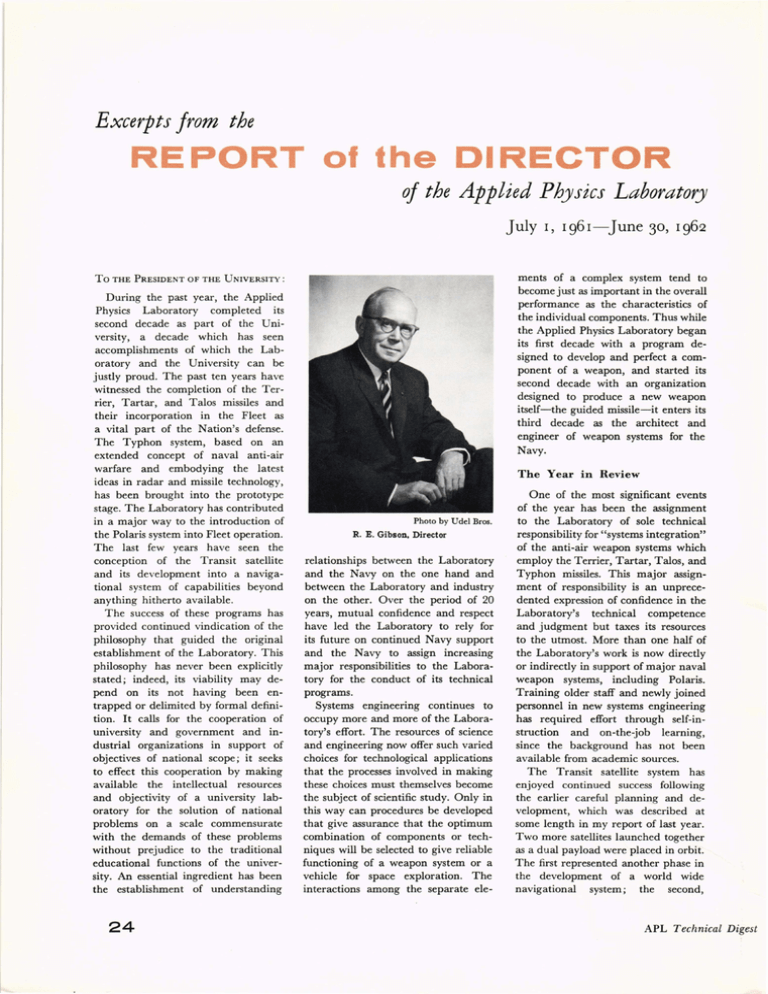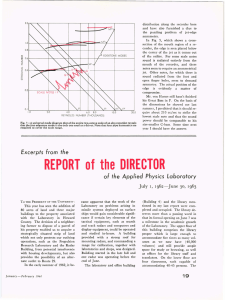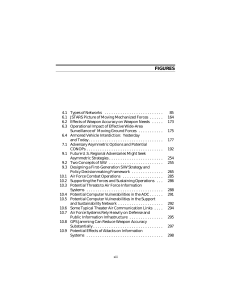REPORT the DIRECTOR of Excerpts from the
advertisement

Excerpts from the REPORT of the DIRECTOR of the Applied Physics Laboratory July To THE 24 1961-June 30, 1962 ments of a complex system tend to become just as important in the overall performance as the characteristics of the individual components. Thus while the Applied Physics Laboratory began its first decade with a program designed to develop and perfect a component of a weapon, and started its second decade with an organization designed to produce a new weapon itself-the guided missile-it enters its third decade as the architect and engineer of weapon systems for the Navy. PRESIDENT OF THE UNIVERSITY : During the past year, the Applied Physics Laboratory completed its second decade as part of the University, a decade which has seen accomplishments of which the Laboratory and the University can be justly proud. The past ten years have witnessed the completion of the Terrier, Tartar, and Talos missiles and their incorporation in the Fleet as a vital part of the Nation's defense. The Typhon system, based on an extended concept of naval anti-air warfare and embodying the latest ideas in radar and missile technology, has been brought into the prototype stage. The Laboratory has contributed in a major way to the introduction of the Polaris system into Fleet operation. The last few years have seen the conception of the Transit satellite and its development into a navigational system of capabilities beyond anything hitherto available. The success of these programs has provided continued vindication of the philosophy that guided the original establishment of the Laboratory. This philosophy has never been explicitly stated; indeed, its viability may depend on its not having been entrapped or delimited by formal definition. It calls for the cooperation of university and government and industrial organizations in support of objectives of national scope; it seeks to effect this cooperation by making available the intellectual resources and objectivity of a university laboratory for the solution of national problems on a scale commensurate with the demands of these problems without prejudice to the traditional educational functions of the university. An essential ingredient has been the establishment of understanding I, The Year in Review Photo by Udel Bros. R. E. Gibson. Director relationships between the Laboratory and the Navy on the one hand and between the Laboratory and industry on the other. Over the period of 20 years, mutual confidence and respect have led the Laboratory to rely for its future on continued Navy support and the Navy to assign increasing major responsibilities to the Laboratory for the conduct of its technical programs. Systems engineering continues to occupy more and more of the Laboratory's effort. The resources of science and engineering now offer such varied choices for technological applications that the processes involved in making these choices must themselves become the subject of scientific study. Only in this way can procedures be developed that give assurance that the optimum combination of components or techniques will be selected to give reliable functioning of a weapon system or a vehicle for space exploration. The interactions among the separate ele- One of the most significant events of the year has been the assignment to the Laboratory of sole technical responsibility for "systems integration" of the anti-air weapon systems which employ the Terrier, Tartar, Talos, and Typhon missiles. This major assignment of responsibility is an unprecedented expression of confidence in the Laboratory's technical competence and judgment but taxes its resources to the utmost. More than one half of the Laboratory's work is now directly or indirectly in support of major naval weapon systems, including Polaris. Training older staff and newly joined personnel in new systems engineering has required effort through self-instruction and on-the-job learning, since the background has not been available from academic sources. The Transit satellite system has enjoyed continued success following the earlier careful planning and development, which was described at some length in my report of last year. Two more satellites launched together as a dual payload were placed in orbit. The first represented another phase in the development of a world wide navigational system; the second, APL Technical Digest TRAAC, carried instruments and equipment for geophysical research. Both satellites have furnished data of great scientific interest. A spectacular achievement was the discovery that the earth has an unsuspected bulge at the equator which was detected by its effect on the gravitational field in which the satellite moves. Information of particular significance has been returned by TRAAC, our radiation investigation satellite. The radiation counters in TRAAC report the proton composition in the inner Van Allen belt on a continuous basis and thus afford a means of immediate correlation with the earth's magnetic activity, w lar surface activity, and similar phys ical phenomena. Additional noteworthy results were obtained which attest to the extraordinary value of the satellite as a new instrument for geophysical research . The satellite program now comprises one-third of the Laboratory activity. The research programs of the Laboratory, although involving a smaller fraction of the staff, constitute a very important part of its operation by providing the basis for future developments and by maintaining its position in the world of science. Several important advances in addition to those mentioned above have resulted from Laboratory research. A scientific solution to one of the most difficult problems in the technology of solid rockets is being steadily realized through painstaking analysis. The onset of violent oscillations in the burning of the propellant, leading often to destruction of the rocket , has been controlled or suppressed in practical use by panaceas which were entirely empirical until this past year. A series of brilliant conjectures about the cause was carefully examined and tested in the framework of physics and chemistry and found to be valid. A clear channel was thereby opened toward real control over the rocket characteristics. The development of a mobile automaton capable of surviving in a restricted environment is an early portent in our program of study on self-organizing systems . D evelopment of a theory to explain heat conduction in polyatomic and polar gases has supplied a solution to a classical problem. A method has been devised for sampling the atoms and radicals present in flames and the results used Jan uar·y - Fe bruary 1963 to explain and predict reaction rates in rocket nozzles. These r epresent a sample taken from a much larger list of research problems, all of commensurate promise and significance. Activities on Major ProgralDs I return now to a brief discussion of the progress and the organizational changes made in support of our major programs. Terrier, Tartar, and Talos In February 1962, a new Laboratory division, the Fleet Systems Division, was formed to devise m ethods to improve the effectiveness of the Terrier, Tartar, and Talos weapon systems installed in the Fleet .. .. The Division has broad technical responsibilities to ensure that all elements of the weapon system work at full effectiveness and in concert. The Laboratory is still concerned with the final engineering stages of the most advanced models of Terrier, Tartar, and Talos missiles. N evertheless, a sufficient portion of this task has been delegated to associate contractors so that these missile divisions have officially been disbanded, with their personnel assigned to the Fleet Systems Division. The Laboratory will, of course, still be prepared to provide assistance in weapon development as it proves to be needed. Typhon The Typhon Weapon System is designed to provide a major improvement in the effectiveness of naval anti-air warfare over the next decade. I t will provide defense in depth against enemy aircraft and airlaunched missiles and also provide for bombardment of surface targets. The Typhon System includes a Laboratory-designed radar, AN/ SPG-59, and a similarly modern weapon direction system. These match the extended range, accuracy, and target-handling capacity of the Typhon system in all operational environments. Typhon is designed to be the successor to the Talos, Tartar, and Terrier generation of weapon systems. years ago. Another, 2-A, is still transmitting after two years. The latest to be launched are Transit Satellite 4-B and the Transit Research and Attitude Control (TRAAC) Satellite which were put in orbit as a dual payload on November 15, 196 1. The Space Systems Group is now d evoting its major effort to the design and construction of the Series 5 Satellites, which are light a nd compact and carry extensive m emory and are equipped with weld ed-wire electronics. The radio n avigation set for use in Polaris submar ines (AN / BRN-3) neared operational r eadiness, and a relatively inexpensive " Transit Integration Doppler N avigator" (TRIDON) is under d evelopment. Existing ground stations in the world-wide Transit tracking complex were updated and new stations were activated in the other hemisphere. Analysis of the results of the tracking of Transit satellites by many widely distributed stations has confirmed the conj ecture that the earth's equator is elliptical rather than circular, with the difference between long and short axes about 150 meters. These and other geodetic contributions from Transit led to an invitation to exhibit in the U . S. Science Pavilion at the 1962 Seattle World's Fair. The Laboratory's exhibit of the use of Transit to determine the size and shape of the earth received a gratifying early and continuing acclaim. Millions will have seen this exhibit, both in person and on one of the national television networks before the Fair closes. Project ANNA, the geodetic satellite sponsored jointly by the Army, Navy and Air Force and under development at this Laboratory was launched on May 9, 1962. A failure in the second stage of the Air Force launching rocket prevented its achieving orbit. A second attempt is soon to follow. The Laboratory has been asked by the National Aeronautics and Space Administration to fabricate two ionospheric research satellites. This Task, known as S-66, has been accepted and is well under way .... Space Systems At present five satellites designed and fabricated in the Laboratory are in orbit. One ceased to radiate two Polaris The Polaris Division participated in the development analysis tests on four 25 Main building complex of the Howard County site of the Applied Physics Laboratory. The new Building 4 (right) and Library (center) are shown in late stages of construction. nuclear submarines at Cape Canaveral: USS Abraham Lincoln, USS Ethan Allen, USS Sam Houston, and USS Thomas A. Edison. The Division also established the methods, mathematical models, and procedures for assessing the reliability and accuracy of the FBM Weapon System. This assessment was made on the basis of nine patrols of SSN(N)-598 class ships. Thirty-five members of the Polaris Analysis and Evaluation Group have received the Navy's Meritorious Public Service Citations for their field support efforts leading to the first submerged firings of Polaris missiles in July 1960. In presenting the certificate, Admiral W. F. Raborn, Jr., Director of the Special Projects Office, expressed his "heartfelt congratulations and sincere appreciation for the Laboratory's effort in helping the Polaris project shorten its schedule by two years or more." Tactical Analysis and Feasibility Studies In addition to conducting studies to provide a sound operational basis for 26 the Laboratory's development work, the Tactical Analysis Division continues to give analytical support to a number of studies currently pursued by the Navy (CNO). Letters of commendation from the Navy were received by nine members of the Planning Analysis Group and seven members of the Computing Center. During the year a number of ad hoc groups were set up in the Laboratory to explore for the Bureau of Naval Weapons the feasibility of new weapon systems to fulfill emerging operational needs. These studies have resulted in a number of special reports. Facilities The new Propulsion Research Laboratory was occupied in March 1961. The Laboratory at Forest Grove, in which the first experiments in the world on supersonic ramjets were conducted, was formally abandoned in May 1962, not without nostalgic memories. Equipped with a plasmaarc heater operating initially at 6 megawatts (and planned for 15 mega- watts), the new laboratory can provide the environment to simulate flight at speeds up to Mach 10 over a simulated altitude regime well in excess of 100,000 ft . This is the most advanced facility for high speed flight research available anywhere. The laboratory also provides facilities for research in support of Typhon needs. The Transit Injection Station Building was occupied in May 1962, when the station's equipment was moved from the Forest Grove location . The Environmental Test Laboratory, and a new Tape Storage building providing climate control designed especially for storage of magnetic recording tape, were both completed this spring. Construction work was started on the new library building scheduled for completion early in 1963, and on Building 4, a significant addition to our office and laboratory space, to be completed shortly thereafter . . .. R. E. GIBSON Director APL T echnical Digest




